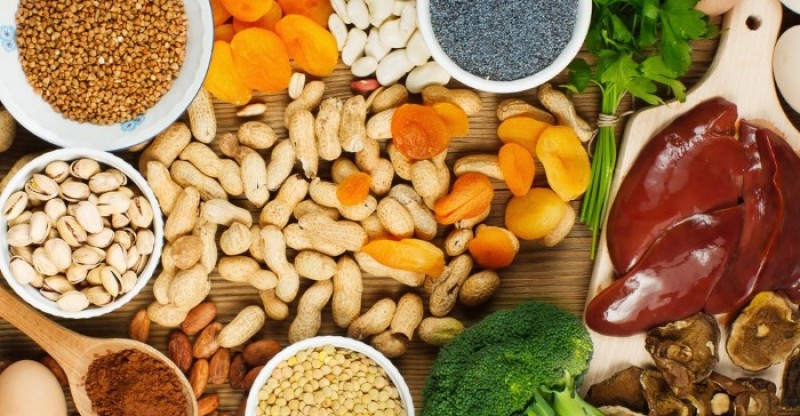15 Healthy Foods that are Very High in Iron
Iron is one of those minerals that people often neglect.
It serves several important functions in the body, such as making red blood cells.(1)
The best way to increase your level of this mineral is to eat foods that contain iron.
By eating these iron-rich foods, you can reach the recommended daily intake of 18 milligrams and avoid anemia.
This condition causes a person to become very tired, confused, and mentally exhausted.
Many individuals suffer from iron deficiency because they don’t eat enough foods that contain iron.
Sadly, there is a strong chance that most people reading this article right now don’t eat enough foods that are high in iron, and so probably suffer from mild to severe anemia.
That’s why we’ve compiled this list of foods with high iron.
Many of these foods may already be a part of your everyday diet.
If none of them are currently in your diet, you need to identify a few that you like and integrate them as quickly as possible.
In this way, you can stay healthy and active, and avoid the dangerous side-effects of anemia.
Dark Chocolate
Chocolate fans can rejoice in the fact that their favorite food is on a shortlist of the best high iron foods available on the market today.(2)
A one-ounce serving of dark chocolate contains about 19 percent of your recommended daily intake of iron.
Even better, it is high in copper (25 percent) and magnesium (16 percent), two minerals that can be hard to obtain elsewhere.
This high level of iron doesn’t mean that you can eat Hershey bars and avoid anemia.
To get these benefits, you need very dark chocolate.
This type of chocolate doesn’t have the same kind of sugar content as more-processed chocolate and may be harder for some people to enjoy.
Nevertheless, if you consume chocolate with a minimum of 70 percent cocoa, you should see positive results.(3)
It is best to avoid eating a lot of this food, though, as it is also rather high in calories.
Turkey
Turkey is often considered one of the healthiest meats because it is so low in fat.
However, it is also high in a variety of nutrients and minerals like iron.(4)
For example, a 3.5-ounce piece of dark meat turkey contains nearly 2.5 milligrams of iron.
This is about 13 percent of your recommended daily intake.
Those who are interested in consuming turkey for iron should concentrate on the dark meat.
The same amount of white meat (3.5 ounces) will have just 1.3 milligrams of iron or about 6-7 percent of your recommended daily intake.
Both servings contain the same amount of calories, too, so stick with dark meat.
Even better, eating high concentrations of protein like this fowl will increase your metabolism.(5)
As a result, you can lose weight and better digest your food.
This benefit also helps avoid the kind of muscle loss that occurs as you age by providing it with the food it needs.
Quinoa
This popular grain is becoming one of the most consistent ways of getting iron without eating too many calories.(6)
For example, one cup of cooked quinoa provides about 15 percent of your recommended daily intake.
While not among the most efficient iron sources, quinoa is low in fat and has other benefits.
For example, it has many different nutrients, including magnesium, copper, folate, and manganese.
It also lacks gluten, making it a useful choice for those pursuing a gluten-free diet.
Beyond these benefits, it can also help protect you against the dangers of free radicals.
This benefit comes from its high concentration of antioxidants.(7)
In fact, quinoa has more antioxidants than any other type of grain.
As a result, it is a useful way of increasing your antioxidant levels without increasing your metabolism.
Broccoli
Broccoli is one of the most nutritious and beneficial vegetables in a person’s diet.(8)
One cup of broccoli contains one milligram, or six percent, of your recommended daily intake of iron.
As a result, its relatively low calories (about 50 per cup) make it a healthy and efficient way to increase your iron level and avoid the dangers of anemia.
An added bonus is that it also provides high levels of vitamin C in every cup.
The 168 percent dose of vitamin C in broccoli is beneficial because it makes it easier for you to absorb iron.
As a result, the efficiency of your iron intake increases when you eat broccoli.
Another incredible benefit of this food is that it contains a variety of plant compounds that can help in the fight against cancer.(9)
While eating broccoli can’t treat this disease, it can decrease your chances of developing it.
Organ Meats
Though it can be hard to adapt to eating liver, kidney, and heart meat, doing so can be very beneficial.
These meats have some of the highest concentrations of iron of any food.(10)
For example, a 3.5-ounce serving of liver has 36 percent, or 6.5 milligrams, of iron.
While this will be high in calories, the iron content makes consumption worth it.
Liver and other organ meats are also unusually high in protein and other beneficial nutrients.
For example, a serving of organ meat has a significant amount of copper and selenium.
It also has high concentrations of B-vitamins.
These beneficial nutrients help improve your metabolism and other aspects of your health.
Another nice benefit of eating liver is that it provides you with choline.(11)
This particular nutrient improves the health of the brain and liver.
As a result, organ meat is often considered a great way to improve concentration and focus.
Raisins
A single cup of raisins has 3.1 milligrams of iron or about 17 percent of your recommended daily intake.(12)
Unfortunately, that cup also contains about 493 calories, making it one of the less efficient ways to increase your iron intake.
However, raisins have been shown to help fight off many of the symptoms of anemia.
For example, a single serving of raisins every day will help increase your production of red blood cells and improve your cardiovascular health.(13)
As red blood cells carry oxygen and remove carbon dioxide from your body, you will feel happier, healthier, and have a clearer head.
Molasses
Molasses is a sweetener that a growing number of people are using to fight off symptoms of anemia.
For example, a single cup contains 88 percent of your recommended daily intake of iron.(14)
However, a variety of studies has found that blackstrap molasses can be a powerful tool in the fight against anemia.(15)
There is a downside to this choice.
Of all the foods that contain iron, it is the least efficient, with nearly 1,000 calories contained in a single cup.
It is best to use no more than a single teaspoon of molasses in a cup of tea or coffee in the morning.
This dosage still provides you with a significant level of iron.
Besides, integrating a variety of foods that are high in iron like this helps increase the diversity of your diet.
Shellfish
Shellfish has some of the highest concentrations of iron naturally available.(16)
For example, even a few ounces of clams can contain over 100 percent of your daily iron intake.
An interesting characteristic of iron is that you can store more than your recommended daily intake in your body.
As a result, it is possible to stockpile it to avoid anemia.
Since many types of shellfish provide you with up to 150 percent of your iron intake, eating a healthy amount of this food can help you recover from anemia.
We suggest eating a single serving of clams to get all the iron you need in a day.
Tuna
Tuna is one popular type of fish that is fairly high in iron.
In a single cup serving of tuna, you get 2.4 milligrams, or 13 percent, of your recommended daily intake.(17)
With just 179 calories in that serving, it is also one of the most efficient ways to get a large amount of iron quickly.
In fact, a single can of tuna provides almost 30 percent of your iron for the day.
While concerns of mercury poisoning may cause some people to avoid seafood, tuna has too many benefits to ignore.
For example, it possesses a selenium compound that has been shown to protect against both oxidation and the formation of free radicals.
As a result, tuna and its high concentration of iron may help protect a person from the development of cancer or other serious conditions.(18)
In fact, it may even help reduce the symptoms of aging, such as wrinkles and decreased lung capacity.
Strawberries
While strawberries may not have the highest concentration of iron, their caloric content is low enough to compensate.
For example, a cup of halved strawberries has three percent of your recommended daily intake of iron, and just 48 calories.(19)
As a result, three times that amount would be just 150 calories and provide nearly 10 percent of your daily intake.
Beyond these benefits, strawberries provide a variety of other advantages.
For example, they have been shown to increase your cardiovascular health and to serve as a powerful antioxidant.
While other berries may have similar health benefits, strawberries remain among the most efficient, delicious, and easy-to-prepare available.
Try to eat a minimum of one cup every day to see real improvement.
Tofu
This popular vegetarian dish is among the best high-iron foods on our list.
For example, a half cup serving has nearly 19 percent of your recommended daily intake of this mineral.(20)
Tofu is also high in protein and is a great fat-free replacement for meat.
However, it is also very high in a variety of other minerals, including magnesium, selenium, thiamin, and calcium.
Its high concentration of isoflavones has also been shown to produce many significant benefits in a broad range of people.
For example, isoflavones have been shown to decrease your risk of heart disease, improve your sensitivity to insulin, and manage severe menopause symptoms.(21)
As a result, doctors often suggest it to anemic women who are just about to enter this challenging phase of their life.
Pumpkin Seeds
With a concentration of 4.2 milligrams of iron per ounce, pumpkin seeds are incredibly rich in this nutrient.
In fact, a one-ounce serving has nearly a quarter of your recommended daily intake of iron.
It contains high levels of magnesium, vitamin K, zinc, and manganese.
In fact, that same one-ounce serving contains 37 percent of your recommended daily intake of magnesium.
This incredible nutrient helps reduce your risk of diabetes by decreasing your risk of insulin resistance.
It also prevents the onset of acute depressive symptoms.
Spinach
While eating spinach won’t make you bulk up like Popeye, it is still an incredible food to integrate into your diet.
For example, a 3.5-ounce serving of cooked spinach will provide you with 3.6 milligrams of iron.(22)
That is about 20 percent of your recommended daily intake.
With just 20 calories per serving, spinach is likely the most efficient way to get iron.
That said, it wouldn’t be nearly as useful if it didn’t contain vitamin C.
Concentrations of this vitamin in spinach increase your ability to absorb iron and increase your metabolism.
As a result, pairing spinach with other high-iron foods can enhance their efficiency as sources of iron.
Beyond these benefits, spinach has high levels of carotenoids that help reduce your risk of developing serious cancer.(23)
However, these nutrients also help decrease any inflammation that is affecting your life and improve your vision.
Keep in mind that pairing healthy fats with spinach increases its benefits.
Legumes
These simple foods are among the richest sources of iron in the world.
For example, a cup of cooked lentils has nearly 37 percent of your recommended daily intake of iron or 6.6 milligrams.(24)
As it is low in calories and fat, this makes it an efficient iron source.
Types of legumes you can integrate into your diet include beans, chickpeas, soybeans, peas, and lentils.
As mentioned previously, tofu is a popular way of increasing your intake of soy.
However, you can also cook lentils and layer them over quinoa for an even higher dose of iron.
Beyond these benefits, legumes are also rich in folate, magnesium, and potassium.(25)
Studies have shown that these nutrients help reduce inflammation, manage diabetes symptoms, and decrease your risk of serious heart disease.
Red Meat
High in protein and fat, red meat is also very rich in iron.(26)
It contains about 15 percent of your recommended daily intake in a 3.5-ounce serving.
Those looking to lose weight should avoid red meat, though, as it is high in calories and problematic fat.
That said, its high concentration of protein, zinc, and selenium do help to offset the risk of weight gain.
Even better, red meat can be used in just about any type of meal.
For example, it is possible to eat it as bacon for breakfast, as a taco salad at lunch, and as a piece of steak at supper.
It is also the best source of iron for those who exercise regularly.
One study found that people who ate red meat retained iron more efficiently after regular exercise.(27)
It is, therefore, a good idea to integrate a healthy amount of red meat into your diet.
Integrating These Foods Into Your Diet
As you can see, there are many different types of foods that you can use to integrate iron into your diet.
Now that you know what these items are, it is important to learn how to use them in your diet.
For some people, it may be hard to incorporate some of these foods.
For example, some people may simply have no taste for tuna.
That’s not a major problem because you can integrate shellfish into your diet as a replacement.
In other instances, a person may simply prefer white meat turkey.
While the dark meat is more beneficial than white, the latter is still an excellent choice.
Remember that you don’t need to integrate all of these foods into your diet, or eat them at a level that is too high for you.
For example, you don’t need to eat a whole serving of lentils to get some iron in your diet.
Balance it out with a tastier substitute.
It is also important to talk to your doctor before making any significant changes to your diet.
Trying to overeat iron too soon may not be a good choice for some people.
They can help you create a diet plan that slowly introduces into your diet foods that have iron.
FDA Compliance
The information on this website has not been evaluated by the Food & Drug Administration or any other medical body. We do not aim to diagnose, treat, cure or prevent any illness or disease. Information is shared for educational purposes only. You must consult your doctor before acting on any content on this website, especially if you are pregnant, nursing, taking medication, or have a medical condition.
HOW WOULD YOU RATE THIS ARTICLE?






